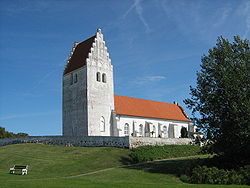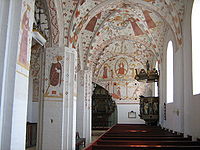
Fanefjord Church
Encyclopedia

Møn
-Location:Møn is located just off the south-eastern tip of Zealand from which it is separated by the waters of the Hølen strait between Kalvehave and the island of Nyord, at the northern end of Møn. Further south is Stege Bugt...
's most famous attractions, is located in an open setting overlooking the Baltic Sea
Baltic Sea
The Baltic Sea is a brackish mediterranean sea located in Northern Europe, from 53°N to 66°N latitude and from 20°E to 26°E longitude. It is bounded by the Scandinavian Peninsula, the mainland of Europe, and the Danish islands. It drains into the Kattegat by way of the Øresund, the Great Belt and...
inlet of Fanefjord between Store Damme
Store Damme
Store Damme is a village in Fanefjord Parish on the western part of the Danish island of Møn, Vordingborg Municipality. With a population of 639 it is the second largest community on the island after Stege....
and Hårbølle
Hårbølle
Hårbølle is a harbour village on the Danish island of Møn some 5 km south of Store Damme. It is located in the parish of Fanefjord in Vordingborg Municipality. Today it is a popular pleasure boat harbour and summer house resort.-History:...
. Standing majestically on the top of a small hill, the church's red-tiled roof and whitewashed walls can be seen from considerable distances, whatever the direction. The interior is of particular interest in view of the many fresco
Church frescos in Denmark
Church frescos or church wall paintings are to be found in some 600 churches across Denmark, no doubt representing the highest concentration of surviving church murals anywhere in the world. Most of them date back to the Middle Ages...
s dating back to the 13th and 16th centuries.
History

Grønsalen
Grønsalen or Grønjægers Høj is located near Fanefjord Church on the Danish island of Møn. Some 100 metres long and 10 metres wide, it is Denmark's largest long barrow and is widely recognised as one of Europe's outstanding ancient monuments....
, the supposed burial ground of Queen Fane (cf Fanefjord) and her husband Grøn Jæger (or Green Hunter) who, according to local folklore, lived some 4,000 years ago.
The church's original 7 m high nave dates back to the second half of the 13th century. The cross vaults in the nave were added around 1300. In about 1500, the porch and tower were completed and the choir was built around 1660.
In 1825, the church was bought by the Klintholm Estate which maintained ownership for almost 100 years.
It may appear surprising that such a large church was built at a time (1250) when the parish only had about 300 inhabitants. One explanation may be that there was considerable trade through the fjord with the German Hanseatic ports
Hanseatic League
The Hanseatic League was an economic alliance of trading cities and their merchant guilds that dominated trade along the coast of Northern Europe...
. The traders may well have contributed to the construction, both financially and by helping with the work.
Frescos

Church frescos in Denmark
Church frescos or church wall paintings are to be found in some 600 churches across Denmark, no doubt representing the highest concentration of surviving church murals anywhere in the world. Most of them date back to the Middle Ages...
were hidden under a covering of plaster. After frescos had been discovered at the end of the 19th century in Møn's Elmelunde Church, those in Fanefjord were painstakingly uncovered from 1932 to 1934 under the guidance of the National Museum
National Museum of Denmark
The National Museum of Denmark in Copenhagen is Denmark’s largest museum of cultural history, comprising the histories of Danish and foreign cultures, alike. The museum's main domicile is located a short distance from Strøget at the center of Copenhagen. It contains exhibits from around the world,...
. In 2009, major restoration work was completed on the frescos, revealing their original colours and impact.
The earliest frescos, on the triumphal arch, were painted around 1350. They depict the four evangelists
Four Evangelists
In Christian tradition the Four Evangelists are Matthew, Mark, Luke, and John, the authors attributed with the creation of the four Gospel accounts in the New Testament that bear the following titles:*Gospel according to Matthew*Gospel according to Mark...
, as well as St Christopher and St George.
The most famous frescos are however those dating back to about 1500 which cover large areas of the church's ceiling and upper walls. In the so-called Biblia pauperum
Biblia pauperum
The Biblia pauperum was a tradition of picture Bibles beginning in the later Middle Ages. They sought to portray the historical books of the Bible visually. Unlike a simple "illustrated Bible", where the pictures are subordinated to the text, these Bibles placed the illustration in the centre,...
style, they present many of the most popular stories from the Old
Old Testament
The Old Testament, of which Christians hold different views, is a Christian term for the religious writings of ancient Israel held sacred and inspired by Christians which overlaps with the 24-book canon of the Masoretic Text of Judaism...
and New Testament
New Testament
The New Testament is the second major division of the Christian biblical canon, the first such division being the much longer Old Testament....
s.

Elmelunde Master
The artist, who can be identified by the emblem he included in the decorations, is known simply as the Elmelunde MasterElmelunde Master
The Elmelunde Master, Danish Elmelundemesteren, is the designation given to the nameless 16th century artist who painted the frescoes in the churches of Elmelunde, Fanefjord and Keldby on the island of Møn in south-eastern Denmark....
as it was he and his team who also painted the frescos in Elmelunde Church
Elmelunde Church
Elmelunde Church, famous for its frescos, is located in the village of Elmelunde, Møn, in southeastern Denmark. It stands high above the surroundings just south of the main road from Stege to the white cliffs of Møn...
and indeed those in Keldby Church
Keldby Church
Keldby Church, famous for its frescoes, is located on the main road to Møns Klint in the village of Keldby, 4 km east of Stege on the Danish island of Møn....
. Indeed, it is probable that there were several artists in the Elmelunde workshop who collaborated in decorating churches in the area as other emblems and various in style have been observed.
The warm colours ranging from dark red and russet to yellow, green, grey and black are distinctive. Another typical feature is the expressionless faces of the sleepy-eyed people, turned to the left or right while their bodies face the front. All the images, including the surrounding stonework, are decorated with ornaments such as stars, plants and trees. The images themselves appear to have been inspired partly from block-prints
Woodblock printing
Woodblock printing is a technique for printing text, images or patterns used widely throughout East Asia and originating in China in antiquity as a method of printing on textiles and later paper....
from a Dutch or German Biblia Pauperum
Biblia pauperum
The Biblia pauperum was a tradition of picture Bibles beginning in the later Middle Ages. They sought to portray the historical books of the Bible visually. Unlike a simple "illustrated Bible", where the pictures are subordinated to the text, these Bibles placed the illustration in the centre,...
, a book containing some 40 pages of drawings depicting stories from the Bible. Other sources probably included the Bible itself, legends, apocryphal writings and other illustrations. Initially, the wall paintings appear to have covered the entire church including the lower parts of the walls which are now whitewashed. Traces of work in these areas have been found but the images were not sufficiently clear to warrant restoration.
Other features
The church contains a number of other interesting features. From the top of the tower, there are excellent views of Møn, the GrønsundGrønsund
Grønsund is a strait in Denmark separating the island Falster from the islands Møn and Bogø. Grønsund's maximum depth is at approx. 20 metres and the width is between 1 - 4 km. Storstrømmen channel is situated to the west and Stege Bugt lies to the north between Zealand and Møn. A ferry crosses the...
Strait and the island of Falster
Falster
Falster is an island in south-eastern Denmark with an area of 514 km² and 43,398 inhabitants as of 1 January 2010. Located in the Baltic sea, it is part of Region Sjælland and is administered by Guldborgsund Municipality...
, as well as the southern coast of Zealand. The following also deserve attention:
The choir
The choir, which was renovated in the 17th century in a different, but compatible style, consists of an impressive altarpieceAltarpiece
An altarpiece is a picture or relief representing a religious subject and suspended in a frame behind the altar of a church. The altarpiece is often made up of two or more separate panels created using a technique known as panel painting. It is then called a diptych, triptych or polyptych for two,...
, the original candlesticks and a new altar.
The pulpit
The ornate pulpitPulpit
Pulpit is a speakers' stand in a church. In many Christian churches, there are two speakers' stands at the front of the church. Typically, the one on the left is called the pulpit...
is from about 1645 and bears Christian IV's emblem. Among the carved figures are Christ
Christ
Christ is the English term for the Greek meaning "the anointed one". It is a translation of the Hebrew , usually transliterated into English as Messiah or Mashiach...
, Jacob
Jacob
Jacob "heel" or "leg-puller"), also later known as Israel , as described in the Hebrew Bible, the Talmud, the New Testament and the Qur'an was the third patriarch of the Hebrew people with whom God made a covenant, and ancestor of the tribes of Israel, which were named after his descendants.In the...
, St Peter and one of the apostles.
The organ
A new organ built by Frobenius & SønnerFrobenius Orgelbyggeri
-History:Frobenius Orgelbyggeri was founded in Copenhagen by Theodor Frobenius in 1909. The firm moved to Lyngby in 1925. Theodor's sons Walther and Erik joined the company in 1944, at the same time that they began to build organs in the classical tradition, with mechanical actions and slider...
with 10 stops, two keyboards and a pedalboard, was installed in 1998.
External links
- History of Fanefjord Church from the parish website. Retrieved 5 August 2009.
- Local History pages of the Fanefjord Sogns Grundejer- & Beboerforening (in Danish). Retrieved 30 July 2007.
- Elmelundemesteren from the Insula Moenia site. Retrieved 1 August 2007.
Sources
- Pastor Helge Buus: Fanefjord Kirke, Fanefjord menighedsråd, Askeby, 1978, Fanefjord menighedsråd, 19 p.
- Birgit Als Hansen: De Mønske Kirker, Møns Turistforening, Stege, 1967, 11 p. (translated 1976 as The churches of Møn)
- Annett Scavenius: Elmelundemestern i Fanefjord Kirke, Forlaget Vandkunsten, 2010, 121 p. ISBN 9788776951238.

